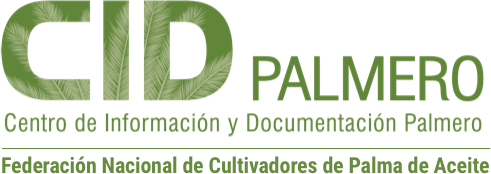| dc.creator | Ramírez-Contreras, Nidia Elizabeth | |
| dc.creator | Munar-Flórez, David Arturo | |
| dc.creator | Albarracín-Arias, Jorge Alberto | |
| dc.creator | Romero-Rincón, Víctor | |
| dc.creator | Arias-Camayo, Phanor | |
| dc.creator | Ardila-Badillo, Camilo | |
| dc.creator | García-Núñez, Jesús Alberto | |
| dc.creator | Cuellar-Sánchez, Mónica | |
| dc.date | 2024-09-19 | |
| dc.date.accessioned | 2025-03-14T11:23:34Z | |
| dc.date.available | 2025-03-14T11:23:34Z | |
| dc.identifier | 10.56866/01212923.14265 | |
| dc.identifier.uri | https://repositorio.fedepalma.org/handle/123456789/145760 | |
| dc.description | By estimating greenhouse gas (GHG) emissions from the stages of the life cycle of crude palm oil (CPO), the carbon footprint (CF) is obtained. The constant calculation of the CF facilitates the identification of opportunities for improvement in the production chain, through the application of good low-carbon practices, with the aim of minimizing environmental impacts associated with GHG emissions. The present study estimates the carbon footprint of the CPO for Colombia with data from 2021 collected in palm plantations and processing plants in the country. These data correspond to 85 % of CPO production and 36 % of fresh fruit bunch production. The results show a carbon footprint of 182 kg CO2eq t-1 CPO produced and indicate that the treatment of POME (CH4 generation), the use and application of chemical fertilizers and land use change (direct LUC) are the main factors that contribute to the generation of GHG emissions in the Colombian palm oil sector. The emissions associated with the LUC from oil palm planting correspond to the analysis by palm tree area of the landscape transformation based on satellite images of the reference period 2007-2020. | en-US |
| dc.description | El presente estudio hace una estimación de la huella de carbono del APC para Colombia con datos del año 2021 recolectados en plantaciones de palma y plantas de beneficio del país. Estos datos corresponden al 85 % de la producción de APC y el 36 % de la producción de racimos de fruta fresca. Los resultados muestran una huella de carbono de 182 kg CO2eq t-1 APC producido y también indican que el tratamiento del POME (generación de CH4), el uso y aplicación de fertilizantes químicos y el cambio del uso del suelo (CUS directo) son los principales factores que contribuyen a la generación de emisiones de GEI en el sector palmicultor colombiano. Las emisiones asociadas al CUS por la siembra de palma de aceite corresponden al análisis por zona palmera de la transformación del paisaje con base en imágenes de satélite del periodo de referencia 2007-2020. | es-ES |
| dc.format | application/pdf | |
| dc.format | text/xml | |
| dc.language | spa | |
| dc.publisher | Fedepalma | es-ES |
| dc.relation | https://publicaciones.fedepalma.org/index.php/palmas/article/view/14265/14223 | |
| dc.relation | https://publicaciones.fedepalma.org/index.php/palmas/article/view/14265/14226 | |
| dc.relation | /*ref*/Berry, M., Flamm, R., Hazen, B., & MacIntyre, R. (1994). The Land-Use Change Analysis System (LUCAS) for Evaluating Landscape Management Decisions. IEEE Computational Science and Engineering, 1753, 1-24. | |
| dc.relation | /*ref*/Boix-Fayos, C., & de Vente, J. (2023). Challenges and potential pathways towards sustainable agriculture within the European Green Deal. Agricultural Systems, 207, 103634. https://doi.org/10.1016/j.agsy.2023.103634 | |
| dc.relation | /*ref*/Chaparro-Triana, D., Ramírez-Contreras, N., Munar-Flórez, D., García-Núñez, J., Cammaert, C., & Rincón-Bermúdez, S. (2020). Guia de mejores practicas bajas en carbono asociadas a la produccion de aceite de palma sostenible en Colombia. Cenipalma, WWF-Colombia. | |
| dc.relation | /*ref*/Cuellar, M. (2023). Tecnologias y potencial de generacion de biogas en el sector palmero colombiano.Fedepalma. | |
| dc.relation | /*ref*/European Commission. (2020). EU strategy to reduce methane emissions. European Commision. https://energy.ec.europa.eu/topics/oil-gas-and-coal/methane-emissions_en | |
| dc.relation | /*ref*/Fedepalma. (2023). Anuario estadístico 2023: principales cifras de la agroindustria de la palma de aceite en Colombia y en el mundo 2018-2022. | |
| dc.relation | /*ref*/Furumo, P. R., & Aide, T. M. (2017). Characterizing commercial oil palm expansion in Latin America: Land use change and trade. Environmental Research Letters, 12(2). https://doi.org/10.1088/1748-9326/aa5892 | |
| dc.relation | /*ref*/Garcia-Nunez, J. A., Ramirez-Contreras, N. E., Rodriguez, D. T., Silva-Lora, E., Frear, C. S., Stockle, C., & Garcia-Perez, M. (2016). Evolution of palm oil mills into bio-refineries: Literature review on current and potential uses of residual biomass and effluents. Resources, Conservation and Recycling, 110, 99-114. https://doi.org/10.1016/j.resconrec.2016.03.022 | |
| dc.relation | /*ref*/Garcia-Nunez, J. A., Rodriguez, D. T., Fontanilla, C. A., Ramirez, N. E., Silva, E. E., Frear, C. S., Stockle, C., Amonette, J., & Garcia-Perez, M. (2016). Evaluation of alternatives for the evolution of palm oil mills into biorefineries. Biomass and Bioenergy, 95, 310-329. https://doi.org/10.1016/j.biombioe.2016.05.020 | |
| dc.relation | /*ref*/Gobierno de Colombia. (2020). Actualizacion de la Contribucion Determinada a Nivel Nacional de Colombia (NDC) (p. 112). Gobierno de Colombia. | |
| dc.relation | /*ref*/Instituto de Hidrología, Meteorología y Estudios Ambientales. (2010). Leyenda nacional de coberturas de la tierra. Metodologia CORINE Land Cover adaptada para Colombia, escala 1:100.000. Ideam. | |
| dc.relation | /*ref*/Instituto de Hidrología, Meteorología y Estudios Ambientales. (2011). Estimación de las emisiones de dióxido de carbono generadas por deforestación durante el periodo 2005-2010. Ideam. | |
| dc.relation | /*ref*/International Energy Agency. (2022). Biomass and the environment. U.S. Energy Information Administration. https://www.eia.gov/energyexplained/biomass/biomass-and-the-environment.php#:~:text=Burning either fossil fuels or,a carbon-neutral energy source | |
| dc.relation | /*ref*/Panel Intergubernamental de Expertos sobre el Cambio Climático. (2019). 2019 Refinement to the 2006 IPCC Guidelines for National Greenhouse Gas Inventories, Calvo Buendia, E., Tanabe, K., Kranjc, A., Baasansuren, J., Fukuda, M., Ngarize S., Osako, A., Pyrozhenko, Y., Shermanau, P. and Federici, S. (eds). https://www.ipcc.ch/report/2019-refinement-to-the-2006-ipcc-guidelinesfor-national-greenhouse-gas-inventories/ | |
| dc.relation | /*ref*/Panel Intergubernamental de Expertos sobre el Cambio Climático. (2020). Climate Change and Land. An IPCC Special Report on climate change, desertification, land degradation, sustainable land management, food security, and greenhouse gas fluxes in terrestrial ecosystems.https://www.ipcc.ch/srccl/ | |
| dc.relation | /*ref*/Lambin, E. F., Turner, B. L., Geist, H. J., Agbola, S. B., Angelsen, A., Bruce, J. W., … Xu, J. (2001). The causes of land-use and land-cover change: moving beyond the myths. Global Environmental Change, 11(4), 261-269. https://doi.org/10.1016/S0959-3780(01)00007-3 | |
| dc.relation | /*ref*/Ministerio de Ambiente y Desarrollo Sostenible. (2012). Estrategia Colombiana de Desarrollo Bajo en Carbono - ECDBC. | |
| dc.relation | /*ref*/Ministerio de Ambiente, Vivienda y Desarrollo Territorial. (2010). Politica Nacional de Produccion y Consumo: Hacia una cultura de consumo sostenible y transformacion productiva. Viceministerio de Ambiente. https://www.minambiente.gov.co/wp-content/uploads/2021/06/polit_nal_produccion_consumo_sostenible.pdf | |
| dc.relation | /*ref*/Munar-Florez, D., Caro-Caro, C. I., Ramirez-Contreras, N. E., & Garcia-Nuñez, J. A. (2023). Lowcarbon economy for the agricultural sector of the Colombian Orinoquia: an opportunity for bioenergy production. Gestion y Ambiente, 25(2). | |
| dc.relation | /*ref*/Munar Flórez, D, Ramírez Contreras, N y García-Núñez, J. (2024-05-02.). Estimación de la huella de carbono del aceite de palma colombiano: cartilla de uso de la calcula App Ecopalma. Centro de Investigación en Palma de Aceite, Cenipalma. https://repositorio.fedepalma.org/handle/123456789/142876 | |
| dc.relation | /*ref*/Ramirez-Contreras, N. E., Munar-Florez, D. A., Garcia-Nuñez, J. A., Mosquera-Montoya, M., & Faaij, A. P. C. (2020). The GHG emissions and economic performance of the Colombian palm oil sector; current status and long-term perspectives. Journal of Cleaner Production, 258. https://doi.org/10.1016/j.jclepro.2020.120757 | |
| dc.relation | /*ref*/Rincón-Romero, V. O., Molina-Villarreal, A., Zabala-Quimbayo, A., Barrera-Agudelo, O. R., & Torres-Leon, J. L. (2022). The oil palm cadastre in Colombia. Agronomia Colombiana, 40(2), 258-269. https://doi.org/10.15446/agron.colomb.v40n2.98801 | |
| dc.relation | /*ref*/Rivera-Méndez, Y. D., Rodríguez, D. T., & Romero, H. M. (2017). Carbon footprint of the production of oil palm (Elaeis guineensis) fresh fruit bunches in Colombia. Journal of Cleaner Production, 149, 743-750. https://doi.org/10.1016/j.jclepro.2017.02.149 | |
| dc.relation | /*ref*/Velten, S., Leventon, J., Jager, N., & Newig, J. (2015). What is sustainable agriculture? A systematic review. Sustainability, 7(6), 7833-7865. https://doi.org/10.3390/su7067833 | |
| dc.relation | /*ref*/Zabala, S. (2023). Monitoreo nacional de deforestación en Colombia asociada a palma de aceite a partir de sensores remotos. https://satelligence.com/ | |
| dc.rights | Derechos de autor 2024 Palmas | es-ES |
| dc.rights | https://creativecommons.org/licenses/by-nc-nd/4.0 | es-ES |
| dc.source | Palmas; Vol. 45 Núm. 2 (2024): Palmas; 20-39 | es-ES |
| dc.source | 2744-8266 | |
| dc.subject | Aceite de palma crudo | es-ES |
| dc.subject | Biomasa | es-ES |
| dc.subject | Cambio de uso de suelo | es-ES |
| dc.subject | Gases efecto ivernadero | es-ES |
| dc.subject | POME | es-ES |
| dc.title | Colombian Palm Oil: Carbon Footprint and Challenges for Sustainable Production | en-US |
| dc.title | Aceite de palma colombiano: huella de carbono y retos para una producción sostenible | es-ES |
| dc.type | info:eu-repo/semantics/article | |
| dc.type | info:eu-repo/semantics/publishedVersion | |
| dc.identifier.url | https://publicaciones.fedepalma.org/index.php/palmas/article/view/14265 | |


